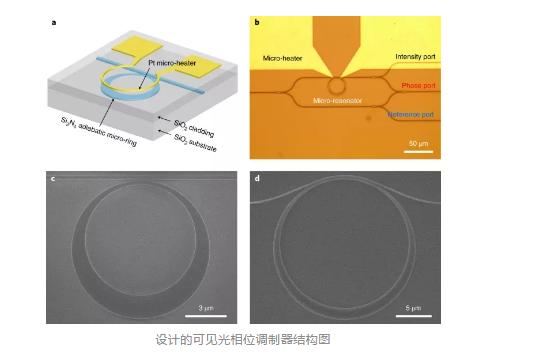In recent years, researchers from various countries have used integrated photonics to successively realize the manipulation of infrared light waves and apply them to high-speed 5G networks, chip sensors, and autonomous vehicles. At present, with the continuous deepening of this research direction, researchers have begun to carry out in-depth detection of shorter visible light bands and develop more extensive applications, such as chip-level LIDAR, AR/VR/MR (enhanced/virtual/hybrid) Reality) Glasses, holographic displays, quantum processing chips, optogenetic probes implanted in the brain, etc.
The large-scale integration of optical phase modulators is the core of the optical subsystem for on-chip optical routing and free-space wavefront shaping. These two prima ry functions are essential for the realization of various applications. However, for optical phase modulators in the visible light range, it is particularly challenging to meet the requirements of high transmittance and high modulation at the same time. To meet this requirement, even the most suitable silicon nitride and lithium niobate materials need to increase the volume and power consumption.
To solve this problem, Michal Lipson and Nanfang Yu of Columbia University designed a silicon nitride thermo-optic phase modulator based on the adiabatic micro-ring resonator. They proved that the micro-ring resonator operates in a strong coupling state. The device can achieve phase modulation with minimal loss. Compared with ordinary waveguide phase modulators, the device has at least an order of magnitude reduction in space and power consumption. The related content has been published in Nature Photonics.

Michal Lipson, a leading expert in the field of integrated photonics, based on silicon nitride, said: “The key to our proposed solution is to use an optical resonator and operate in a so-called strong coupling state.”
The optical resonator is a highly symmetrical structure, which can convert a small refractive index change into a phase change through multiple cycles of light beams. Generally, it can be divided into three different working states: “under coupling” and “under coupling.” Critical coupling” and “strong coupling.” Among them, “under coupling” can only provide limited phase modulation and will introduce unnecessary amplitude changes, and “critical coupling” will cause substantial optical loss, thereby affecting the actual performance of the device.
To achieve complete 2π phase modulation and minimal amplitude change, the research team manipulated the microring in a “strong coupling” state. The coupling strength between the microring and the “bus” is at least ten times higher than the loss of the microring. After a series of designs and optimization, the final structure is shown in the figure below. This is a resonant ring with a tapered width. The narrow waveguide part improves the optical coupling strength between the “bus” and the micro-coil. The wide waveguide part The light loss of the microring is reduced by reducing the optical scattering of the sidewall.

Heqing Huang, the first author of the paper, also said: “We have designed a miniature, energy-saving, and extremely low-loss visible light phase modulator with a radius of only 5 μm and a π-phase modulation power consumption of only 0.8 mW. The introduced amplitude variation is less than 10%. What’s rarer is that this modulator is equally effective for the most difficult blue and green bands in the visible spectrum.”
Nanfang Yu also pointed out that although they are far from reaching the level of integration of electronic products, their work has dramatically narrowed the gap between photonic switches and electronic switches. “If the previous modulator technology only allowed the integration of 100 waveguide phase modulators given a certain chip footprint and power budget, then we can now integrate 10,000 phase shifters on the same chip to achieve more complex Function.”
In short, this design method can be applied to electro-optic modulators to reduce the occupied space and voltage consumption. It can also be used in other spectral ranges and other different resonator designs. At present, the research team is cooperating to demonstrate the visible spectrum LIDAR composed of phase shifter arrays based on such microrings. In the future, it can also be applied to many applications such as enhanced optical nonlinearity, new lasers, and new quantum optics.
Article source:https://mp.weixin.qq.com/s/O6iHstkMBPQKDOV4CoukXA
Beijing Rofea Optoelectronics Co., Ltd. located in China’s “Silicon Valley” – Beijing Zhongguancun, is a high-tech enterprise dedicated to serving domestic and foreign research institutions, research institutes, universities and enterprise scientific research personnel. Our company is mainly engaged in the independent research and development, design, manufacturing, sales of optoelectronic products, and provides innovative solutions and professional, personalized services for scientific researchers and industrial engineers. After years of independent innovation, it has formed a rich and perfect series of photoelectric products, which are widely used in municipal, military, transportation, electric power, finance, education, medical and other industries.
We are looking forward to cooperation with you!
Post time: Mar-29-2023





